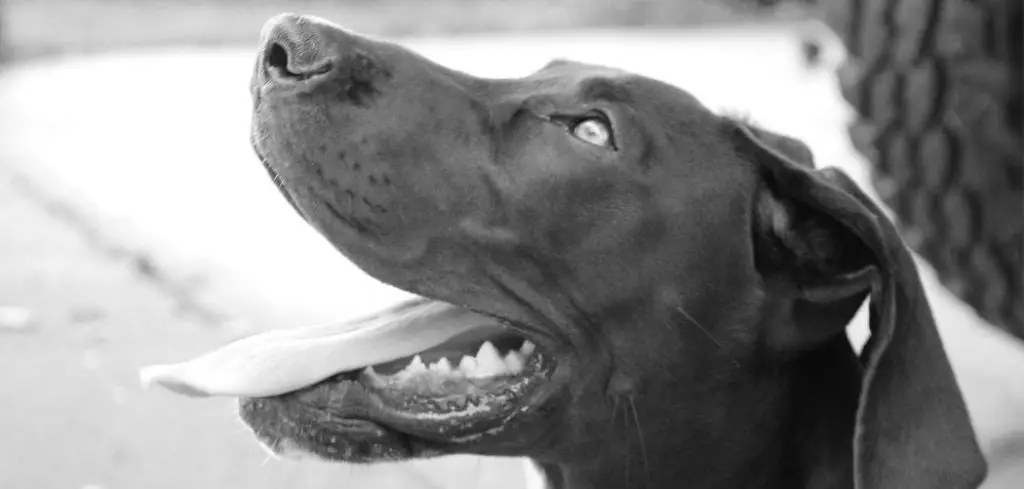It can be alarming to see your dog with their tongue hanging out while refusing food. This unusual combination might indicate an underlying issue.
We outline the common causes of dog tongue out and not eating, what you can do at home, and when to seek veterinary help.
Dog Tongue Out and Not Eating — Why It Happens
When your dog has their tongue sticking out and isn’t eating, it may point to oral pain, neurological dysfunction, nausea, or even respiratory distress. Dental disease can make chewing painful, while some neurological disorders may prevent the tongue from retracting properly. Nausea, dehydration, or overheating can also cause a dog to let their tongue droop while refusing food.

Common Causes of Dog Tongue Out and Not Eating
Dental Disease or Oral Injury
Dental infections, broken teeth, or oral tumors can cause significant mouth pain. Dogs experiencing this may keep their tongue out due to swelling, pain, or an inability to close their mouth comfortably.
As a result, they often avoid eating, especially hard kibble, due to the discomfort.
You might also notice drooling, bad breath, or bleeding gums alongside the tongue protrusion.
If left untreated, oral pain can lead to weight loss and worsening infection.
Read more: Dog Not Eating and Snoring (What it might mean for your pup)
Neurological Disorders
Conditions like facial nerve paralysis or seizures can affect a dog’s ability to control their facial muscles. If the nerves controlling the tongue are impaired, the dog might be unable to retract it normally.
These neurological issues may also cause poor appetite, changes in behavior, or imbalance. This combination of symptoms usually warrants urgent vet care.
Nausea or Gastrointestinal Upset
When dogs feel nauseous, they often refuse food and may let their tongue hang out as they salivate excessively. Common causes include dietary indiscretion, gastroenteritis, pancreatitis, or motion sickness.
Look for other signs like lip smacking, vomiting, or retching. If the nausea continues beyond a few hours, or if vomiting occurs, veterinary intervention is needed.
Heatstroke or Overheating
Dogs regulate their temperature through panting, and sometimes this results in their tongue lolling out excessively. However, if your dog is panting hard with their tongue out and won’t eat, they could be suffering from heat exhaustion.
Heatstroke is extremely dangerous and can quickly become fatal. Look for other signs such as red gums, excessive drooling, weakness, or collapse.
Foreign Object or Obstruction in the Mouth
If something is stuck in your dog’s mouth or throat—like a stick, bone shard, or toy piece—they may keep their tongue out while struggling to eat. You might also notice pawing at the mouth or drooling.
Never try to forcefully remove an object yourself. If you suspect an obstruction, your vet should examine your dog immediately.
What to Do If Your Dog Is Tongue Out and Not Eating
Start by checking your dog’s mouth (gently) for any visible signs of injury, swelling, or stuck objects. If your dog allows it, examine the tongue and gums for ulcers, bleeding, or signs of infection.
Offer soft, bland food like boiled chicken and rice. This may be easier to eat if your dog has oral pain or nausea. Keep your dog hydrated with clean, fresh water, or add a bit of low-sodium broth to encourage drinking.
Keep your dog in a cool, shaded space, especially if heat is a concern. Monitor closely for vomiting, lethargy, or changes in breathing.
If the tongue remains out for more than a few hours or the refusal to eat lasts through the day, contact your veterinarian.
When to Call or Visit Your Vet
If your dog is not eating for more than 24 hours or showing additional symptoms like vomiting, diarrhea, or lethargy, it’s time to call your vet.
Tongue hanging out with signs of facial paralysis, inability to swallow, or imbalance may indicate a neurological issue that needs urgent care.
Contact your vet immediately if:
The tongue is swollen, discolored, or bleeding.
Your dog seems distressed, lethargic, or in pain.
There are signs of choking, excessive drooling, or pawing at the mouth.
The refusal to eat is accompanied by other symptoms like fever or dehydration.
Read more: Dog Nauseous and Not Eating (How to help a queasy dog)
Key Takeaway
When your dog has their tongue hanging out and won’t eat, it could be a sign of oral discomfort, neurological problems, or a more serious health issue. While mild cases can sometimes be managed at home, persistent symptoms or signs of distress call for prompt veterinary attention.
Trust your instincts, keep your dog comfortable, and don’t hesitate to reach out to your vet if your pup’s symptoms linger or worsen.
